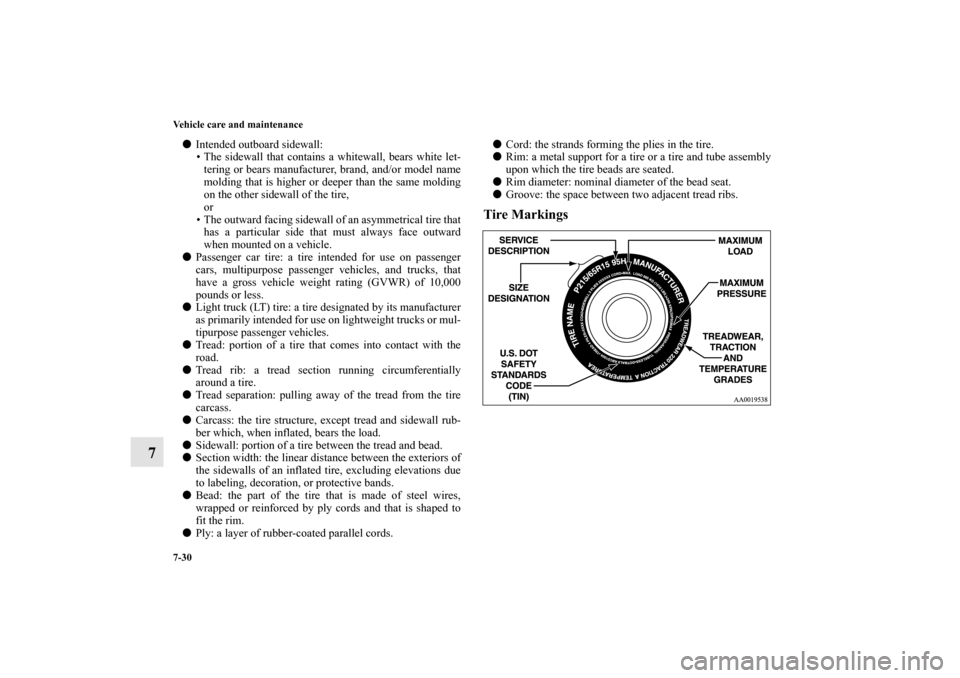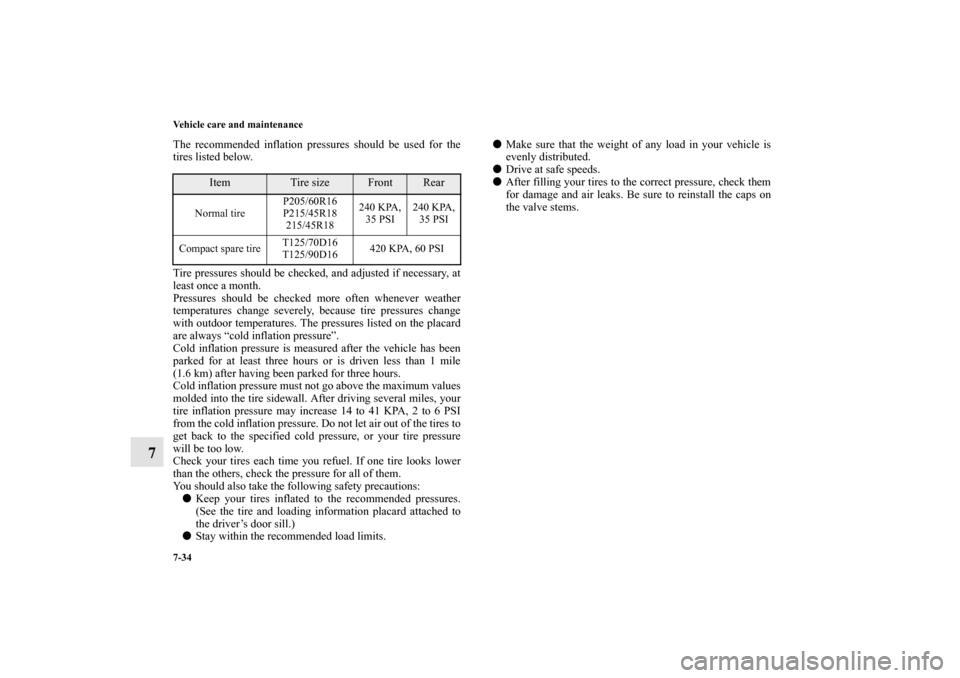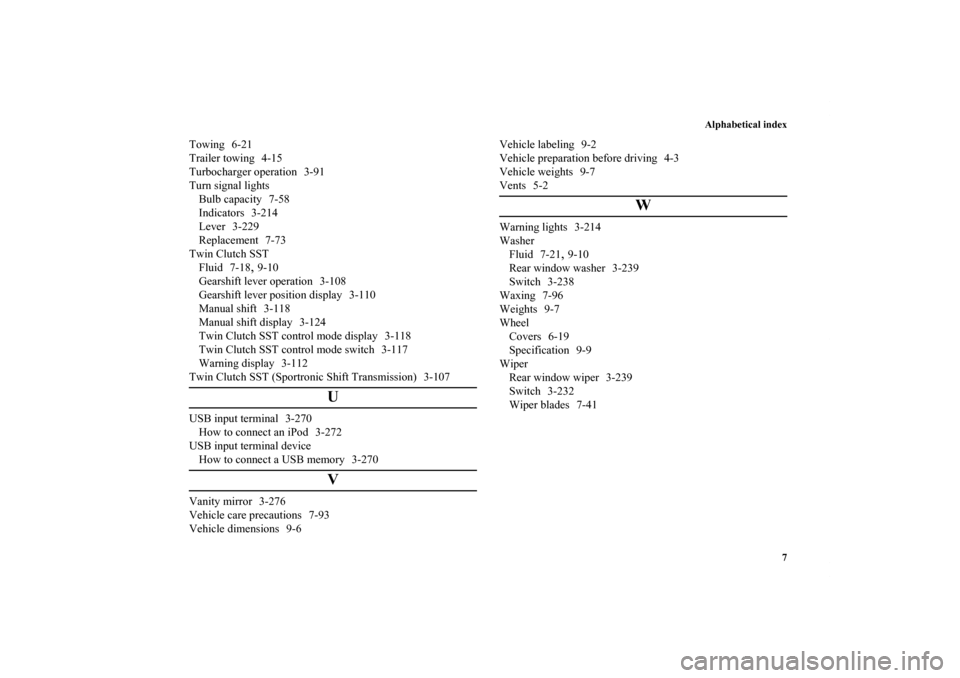Page 609 of 706

7-30 Vehicle care and maintenance
7
�Intended outboard sidewall:
• The sidewall that contains a whitewall, bears white let-
tering or bears manufacturer, brand, and/or model name
molding that is higher or deeper than the same molding
on the other sidewall of the tire,
or
• The outward facing sidewall of an asymmetrical tire that
has a particular side that must always face outward
when mounted on a vehicle.
�Passenger car tire: a tire intended for use on passenger
cars, multipurpose passenger vehicles, and trucks, that
have a gross vehicle weight rating (GVWR) of 10,000
pounds or less.
�Light truck (LT) tire: a tire designated by its manufacturer
as primarily intended for use on lightweight trucks or mul-
tipurpose passenger vehicles.
�Tread: portion of a tire that comes into contact with the
road.
�Tread rib: a tread section running circumferentially
around a tire.
�Tread separation: pulling away of the tread from the tire
carcass.
�Carcass: the tire structure, except tread and sidewall rub-
ber which, when inflated, bears the load.
�Sidewall: portion of a tire between the tread and bead.
�Section width: the linear distance between the exteriors of
the sidewalls of an inflated tire, excluding elevations due
to labeling, decoration, or protective bands.
�Bead: the part of the tire that is made of steel wires,
wrapped or reinforced by ply cords and that is shaped to
fit the rim.
�Ply: a layer of rubber-coated parallel cords.�Cord: the strands forming the plies in the tire.
�Rim: a metal support for a tire or a tire and tube assembly
upon which the tire beads are seated.
�Rim diameter: nominal diameter of the bead seat.
�Groove: the space between two adjacent tread ribs.
Tire Markings
BK0125300US.book 30 ページ 2010年5月18日 火曜日 午後1時53分
Page 613 of 706

7-34 Vehicle care and maintenance
7
The recommended inflation pressures should be used for the
tires listed below.
Tire pressures should be checked, and adjusted if necessary, at
least once a month.
Pressures should be checked more often whenever weather
temperatures change severely, because tire pressures change
with outdoor temperatures. The pressures listed on the placard
are always “cold inflation pressure”.
Cold inflation pressure is measured after the vehicle has been
parked for at least three hours or is driven less than 1 mile
(1.6 km) after having been parked for three hours.
Cold inflation pressure must not go above the maximum values
molded into the tire sidewall. After driving several miles, your
tire inflation pressure may increase 14 to 41 KPA, 2 to 6 PSI
from the cold inflation pressure. Do not let air out of the tires to
get back to the specified cold pressure, or your tire pressure
will be too low.
Check your tires each time you refuel. If one tire looks lower
than the others, check the pressure for all of them.
You should also take the following safety precautions:
�Keep your tires inflated to the recommended pressures.
(See the tire and loading information placard attached to
the driver’s door sill.)
�Stay within the recommended load limits.�Make sure that the weight of any load in your vehicle is
evenly distributed.
�Drive at safe speeds.
�After filling your tires to the correct pressure, check them
for damage and air leaks. Be sure to reinstall the caps on
the valve stems.
Item
Tire size
Front
Rear
Normal tireP205/60R16
P215/45R18
215/45R18240 KPA,
35 PSI240 KPA,
35 PSI
Compact spare tire T125/70D16
T125/90D16420 KPA, 60 PSI
BK0125300US.book 34 ページ 2010年5月18日 火曜日 午後1時53分
Page 686 of 706
9
Specifications
Vehicle labeling . . . . . . . . . . . . . . . . . . . . . . . . . . .9- 2
Vehicle dimensions . . . . . . . . . . . . . . . . . . . . . . . .9- 6
Vehicle weights . . . . . . . . . . . . . . . . . . . . . . . . . . .9- 7
Engine specifications . . . . . . . . . . . . . . . . . . . . . . .9- 8
Battery . . . . . . . . . . . . . . . . . . . . . . . . . . . . . . . . . .9- 9
Tires and wheels. . . . . . . . . . . . . . . . . . . . . . . . . . .9- 9
Refill capacities . . . . . . . . . . . . . . . . . . . . . . . . . . .9- 10
BK0125300US.book 1 ページ 2010年5月18日 火曜日 午後1時53分
Page 692 of 706
Specifications
9-7
9 Vehicle weights
N01147600829
NOTE�Roof load is important because it affects the vehicle capacity weight. Refer to “Loading cargo on the roof” on page 4-13.
GVWR: maximum total weight (load) limit specified for the vehicle
GAWR: maximum weight (load) limit specified for the front or rear axle
Seating capacity: the number of maximum occupants
Item
2.0 liter
2.4 liter
ES
RALLIART
Gross vehicle weight rating (GVWR) 4,013 lb (1,820 kg) 4,509 lb (2,045 kg) 4,190 lb (1,900 kg)Gross axle weight rating
(GAWR)
Front 2,227 lb (1,010 kg) 2,381 lb (1,080 kg) 2,227 lb (1,010 kg)Rear 2,117 lb (960 kg) 2,238 lb (1,015 kg) 2,117 lb (960 kg)
Vehicle capacity weight 827 lb (375 kg)Maximum roof load 110 lb (50 kg)Seating capacity 5 persons
BK0125300US.book 7 ページ 2010年5月18日 火曜日 午後1時53分
Page 704 of 706

Alphabetical index
7
Towing 6-21
Trailer towing 4-15
Turbocharger operation 3-91
Turn signal lights
Bulb capacity 7-58
Indicators 3-214
Lever 3-229
Replacement 7-73
Twin Clutch SST
Fluid 7-18
,9-10
Gearshift lever operation 3-108
Gearshift lever position display 3-110
Manual shift 3-118
Manual shift display 3-124
Twin Clutch SST control mode display 3-118
Twin Clutch SST control mode switch 3-117
Warning display 3-112
Twin Clutch SST (Sportronic Shift Transmission) 3-107
U
USB input terminal 3-270
How to connect an iPod 3-272
USB input terminal device
How to connect a USB memory 3-270
V
Vanity mirror 3-276
Vehicle care precautions 7-93
Vehicle dimensions 9-6Vehicle labeling 9-2
Vehicle preparation before driving 4-3
Vehicle weights 9-7
Vents 5-2
W
Warning lights 3-214
Washer
Fluid 7-21
,9-10
Rear window washer 3-239
Switch 3-238
Waxing 7-96
Weights 9-7
Wheel
Covers 6-19
Specification 9-9
Wiper
Rear window wiper 3-239
Switch 3-232
Wiper blades 7-41
BK0125300US.book 7 ページ 2010年5月18日 火曜日 午後1時53分
Page:
< prev 1-8 9-16 17-24